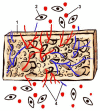In Vivo Bone Tissue Engineering Strategies: Advances and Prospects
- PMID: 35956735
- PMCID: PMC9370883
- DOI: 10.3390/polym14153222
In Vivo Bone Tissue Engineering Strategies: Advances and Prospects
Abstract
Reconstruction of critical-sized bone defects remains a tremendous challenge for surgeons worldwide. Despite the variety of surgical techniques, current clinical strategies for bone defect repair demonstrate significant limitations and drawbacks, including donor-site morbidity, poor anatomical match, insufficient bone volume, bone graft resorption, and rejection. Bone tissue engineering (BTE) has emerged as a novel approach to guided bone tissue regeneration. BTE focuses on in vitro manipulations with seed cells, growth factors and bioactive scaffolds using bioreactors. The successful clinical translation of BTE requires overcoming a number of significant challenges. Currently, insufficient vascularization is the critical limitation for viability of the bone tissue-engineered construct. Furthermore, efficacy and safety of the scaffolds cell-seeding and exogenous growth factors administration are still controversial. The in vivo bioreactor principle (IVB) is an exceptionally promising concept for the in vivo bone tissue regeneration in a predictable patient-specific manner. This concept is based on the self-regenerative capacity of the human body, and combines flap prefabrication and axial vascularization strategies. Multiple experimental studies on in vivo BTE strategies presented in this review demonstrate the efficacy of this approach. Routine clinical application of the in vivo bioreactor principle is the future direction of BTE; however, it requires further investigation for overcoming some significant limitations.
Keywords: axial vascularization; bioreactor; bone regeneration; bone tissue engineering; flap prefabrication; growth factors; in vivo bioreactor; scaffold; stem cells.
Conflict of interest statement
The authors declare no conflict of interest.
Figures
References
-
- Nkenke E., Neukam F.W. Autogenous bone harvesting and grafting in advanced jaw resorption: Morbidity, resorption and implant survival. Eur. J. Oral Implantol. 2014;7((Suppl. S2)):S203–S217. - PubMed
-
- Ritschl L.M., Mücke T., Hart D., Unterhuber T., Kehl V., Wolff K.D., Fichter A.M. Retrospective analysis of complications in 190 mandibular resections and simultaneous reconstructions with free fibula flap, iliac crest flap or reconstruction plate: A comparative single centre study. Clin. Oral Investig. 2021;25:2905–2914. doi: 10.1007/s00784-020-03607-8. - DOI - PMC - PubMed
Publication types
LinkOut - more resources
Full Text Sources



